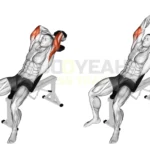Incline One-Arm Dumbbell Tricep Extension Overview
The incline one-arm dumbbell tricep extension is a highly effective isolation exercise that targets the triceps brachii, with particular emphasis on the long head, to build arm strength and definition. Performed on an incline bench, this unilateral movement increases the range of motion, allowing for a deeper stretch in the triceps, which research shows can enhance muscle hypertrophy (source: Journal of Strength and Conditioning Research).
The single-arm approach helps address strength imbalances between arms, making it ideal for both aesthetic goals and functional strength. This exercise engages the core for stability and is suitable for all fitness levels, fitting seamlessly into arm-focused workouts, upper-body routines, or full-body programs. By isolating the triceps, it supports performance in pressing movements like bench presses or push-ups and contributes to toned, sculpted arms. Incorporate the incline one-arm dumbbell tricep extension to boost arm aesthetics and improve pushing power for daily activities.
Incline One-Arm Dumbbell Tricep Extension Instructions
- Set Up the Bench: Adjust an incline bench to a 25-35 degree angle to optimize tricep stretch while maintaining comfort. Ensure the bench is stable and placed in an open area.
- Select a Dumbbell: Choose a dumbbell with a weight that challenges you but allows controlled movement. Beginners should start light (e.g., 5-10 lbs) to focus on form.
- Position Your Body: Lie back on the incline bench, keeping your back flat against the pad and feet firmly planted on the floor for stability. Engage your core and maintain a neutral spine.
- Grip the Dumbbell: Hold a dumbbell in one hand with a neutral grip (palm facing inward). Extend your arm straight above your shoulder, keeping your elbow slightly bent to avoid joint stress. Use your free hand to support your working arm or hold the bench for balance.
- Initiate the Extension: Slowly lower the dumbbell toward your shoulder by bending your elbow, keeping your upper arm stationary and aligned with your torso. Lower until your forearm is parallel to the ground or slightly below for a full stretch.
- Peak Contraction: Extend your arm back to the starting position by contracting your triceps, squeezing at the top for 1-2 seconds to maximize muscle activation. Keep your wrist straight.
- Repeat and Switch: Perform 3 sets of 10-12 reps per arm, resting 60-90 seconds between sets. Switch to the other arm and repeat, ensuring equal effort on both sides.
Incline One-Arm Dumbbell Tricep Extension Tips
- Isolate the Triceps: Keep your upper arm fixed and avoid moving your shoulder to ensure the triceps drive the movement, not momentum or other muscles.
- Controlled Tempo: Use a slow eccentric phase (e.g., 2-3 seconds lowering) to increase time under tension, which research shows promotes muscle growth (source: Sports Medicine).
- Breathing Technique: Exhale as you extend your arm and inhale as you lower the dumbbell to maintain rhythm and core stability.
- Core Engagement: Brace your abs and glutes to prevent arching your lower back or lifting off the bench, reducing strain.
- Start Light: Begin with a lighter weight to master form before increasing resistance to avoid elbow or shoulder discomfort.
- Variation Options: Try using a cable or EZ-curl bar for a different feel, or adjust the incline angle (e.g., 30 vs. 45 degrees) to vary tricep engagement.
- Neck Position: Keep your head resting on the bench in a neutral position to avoid forward jutting, which can strain the cervical spine.
- Progress Gradually: Increase weight or reps as strength improves, but prioritize form to maximize results and minimize injury risk.
Benefits: The incline one-arm dumbbell tricep extension builds stronger, more defined triceps, improves arm symmetry, and enhances pushing strength for exercises like bench presses. It also promotes joint stability and supports functional movements like pushing or lifting overhead.
Targeting triceps with incline extensions? Dive into our Ultimate Guide to Muscle Groups for arm strength.






